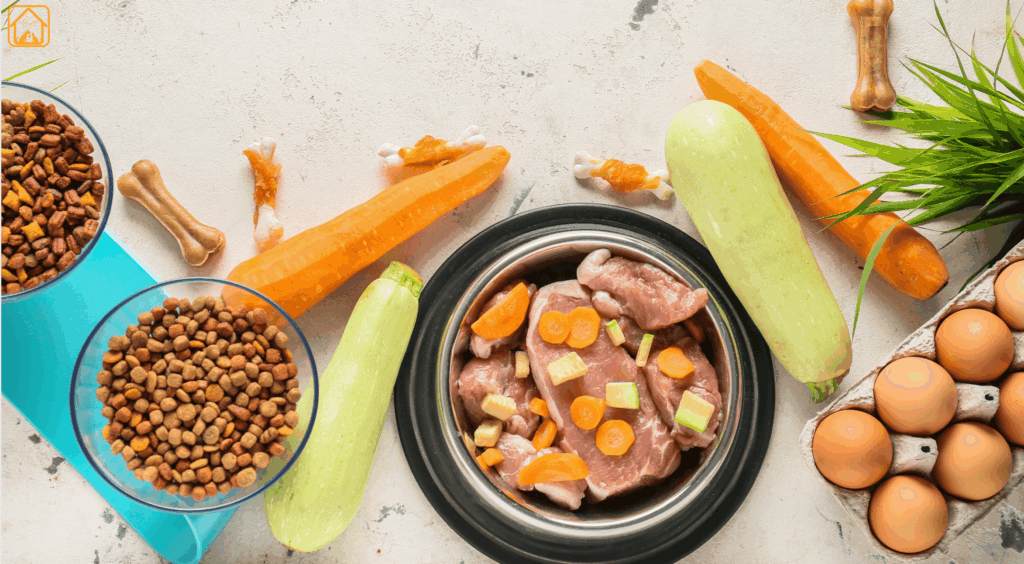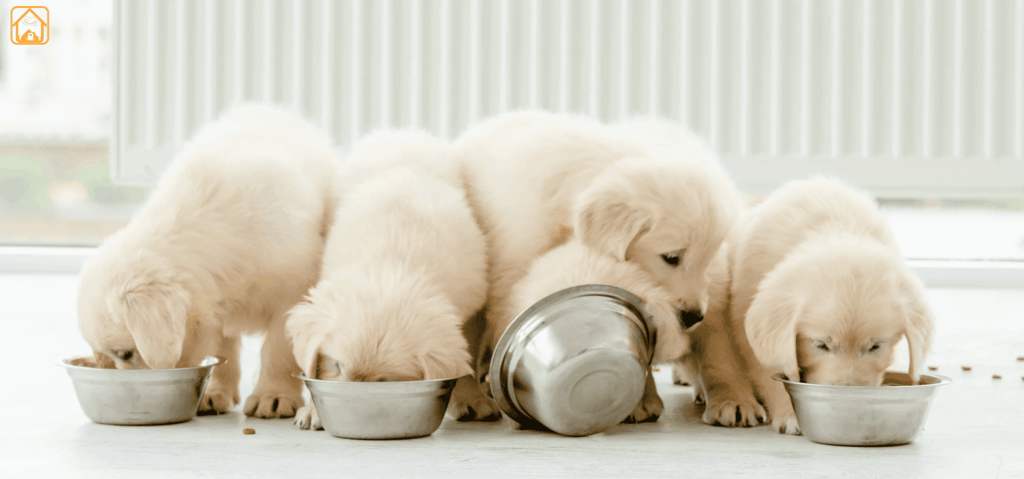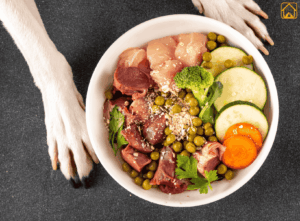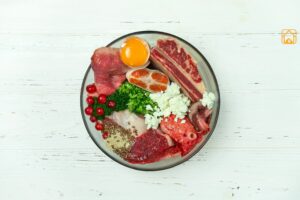In this comprehensive guide, we’ll walk you through everything you need to know about puppy food: what nutrients puppies need, types of food available, age-appropriate feeding schedules, how much to feed, and how to adjust as your puppy grows.
Why the Right Puppy Food Matters
Puppies double, even triple, their weight in months. They need calories, but not just any calories. The right balance of protein, fats, vitamins, and minerals for lifelong health. Bones stretch, muscles develop, brains soak up new tricks, and energy levels seem to skyrocket overnight. Feeding your pup the right puppy food isn’t about spoiling them, it’s about giving their body every it needs.
Not all puppy dog food is created equal. High-quality puppy food for puppies contains carefully balanced protein, fat, and key nutrients for healthy development. The wrong diet can lead to slow growth, weak bones, or even lifelong health issues.
- Growth & Development: Puppies grow rapidly, requiring more calories, protein, and nutrients per pound than adult dogs.
- Immune Support: The right food helps build natural defenses against illness.
- Life-Long Health: Balanced nutrition at this stage helps prevent future health issues such as obesity, joint problems, and allergies.
Nutritional Requirements for Puppies
Puppies are like little athletes, they burn energy quickly and need a complete range of nutrients to support their fast-paced growth. Whether you’re picking puppy dog food from the store or exploring homemade puppy food recipes, understanding the basics of puppy nutrition sets your pet up for success.
What Makes Food Good for Puppies?
Puppies need more calories, protein, and certain minerals than adult dogs. Think of their food like fuel for a race car, it needs to be premium. A great puppy diet should include:
- Protein: Critical for muscle and organ development. Look for high-quality animal proteins as the first ingredient in your puppy food.
- Fats: Provide energy and support brain, eye, and skin health. Essential fatty acids (like DHA) are especially important for puppies.
- Carbohydrates: Offer additional energy for play and learning. Whole grains, sweet potatoes, and rice are digestible sources.
- Vitamins & Minerals: Calcium and phosphorus are vital for strong bones and teeth. Puppies also need iron, zinc, copper, and vitamins A, D, and E for immune and overall health.
- Water: Puppies dehydrate quickly, so fresh water should always be available.
The best puppy food dog formulas are specifically labeled for growth or “all life stages.” Avoid generic “dog food” for young puppies, since it won’t have the right balance.
Why Puppies Need Different Food Than Adult Dogs
- Puppies need up to twice as many calories per pound as adult dogs.
- They require more protein, fat, and specific minerals to support rapid growth and brain development.
- Puppy foods often have smaller kibble sizes for easy chewing and digestion.
Did you know large-breed puppies (like Labs or Goldens) actually need less calcium than small breeds to prevent joint problems? That’s why matching food to your puppy’s breed size is key.
Special Considerations: Large Breeds, Small Breeds, and Sensitive Puppies
- Large Breeds: Need carefully balanced calcium and controlled calories to prevent joint issues. Look for “large breed puppy food”.
- Small Breeds: Require higher calorie density and smaller kibble. Choose “small breed puppy food” or consult your vet.
- Sensitive Puppies: Some may need grain-free, hypoallergenic, or high-fiber puppy food due to allergies or digestive issues. Always check with your veterinarian before making major changes.
Remember that every puppy is an individual. What works for one might not work for another, so always monitor your pup’s weight, energy, coat, and stools, and consult your vet for personalized guidance.
Types of Puppy Food: Dry, Wet, Homemade & More

Choosing the Best Puppy Food for Your Pup
Walk down any pet store and you’ll see a wide range of puppy food options. Here’s how they stack up:
1. Dry Puppy Food (Kibble)
- Pros: Convenient, cost-effective, helps clean teeth, easy to store.
- Cons: It requires access to plenty of water.
- When to use: Most puppies do well on high-quality dry puppy food. Look for reputable brands and formulas labeled for growth.
2. Wet Puppy Food (Canned)
- Pros: Highly palatable, great for picky or small puppies, provides extra hydration.
- Cons: More expensive, can spoil if left out, less convenient for travel.
- When to use: Ideal for puppies transitioning from milk or those with dental issues. Can also be mixed with dry food for variety.
3. Homemade Puppy Food
- Pros: Full control over ingredients; can be tailored for allergies or sensitivities.
- Cons: Difficult to balance nutrients without veterinary guidance; time-consuming; risk of deficiencies.
- When to use: Only with a recipe from a board-certified veterinary nutritionist. Never guess, improper homemade diets can harm puppies.
Want to feed your dog real, healthy food? Our homemade dog food guide will help you make meals that are both delicious and nutritious.
4. Specialized Puppy Formulas
- Large Breed Puppy Food: Lower calcium and controlled calories to protect growing joints.
- Small Breed Puppy Food: Higher calorie density and smaller kibble.
- Grain-Free, Hypoallergenic, High-Fiber: For puppies with allergies, sensitivities, or special digestive needs.
| Puppy Food Type | Best For | Key Features |
| Dry Puppy Food | Most puppies | Crunchy, easy to serve, supports dental health |
| Wet Puppy Food | Picky eaters, hydration | Soft texture, high moisture content |
| Homemade Puppy Food | Puppies with allergies (with vet guidance) | Customizable, must be nutritionally balanced |
| Specialized Formulas | Large/small breeds, sensitivities | Tailored nutrients for unique needs |
Mixing wet and dry can work too, as long as you don’t overfeed. If you’re considering vegan dog food for puppies or other special diets, discuss this with your vet first, puppies have unique needs that are hard to meet on plant-based diets.
Know the difference between wet and dry dog food by reading our Wet vs Dry Food Guide before choosing what’s best for your lovable pup.
Puppy Feeding Schedules by Age & Breed Size
Puppies burn through calories fast, so they need frequent meals. But the right puppy feeding schedule also depends on age and breed size. Here’s a simple breakdown:
| Puppy Age | Meals per Day | Example Times |
| 0–4 weeks | Mother’s milk or puppy milk formula every 2-3 hours | 24/7 (newborns) |
| 4–8 weeks | Transition to solid food, 4 meals/day | 7am, 11am, 3pm, 7pm |
| 2–4 months | 4 meals/day | 7am, 11am, 3pm, 7pm |
| 4–6 months | 3 meals/day | 7am, 1pm, 6pm |
| 6–12 months | 2 meals/day | 8am, 6pm |
Ever tried waking up at 3 AM for a bottle feeding? I have. It’s exhausting but so worth it when you see those little tails wagging with energy the next day!
Large and giant breeds (think Great Dane puppies) may need a different feeding plan to avoid rapid growth that stresses their joints. Always double-check with your vet for a breed-specific puppy feeding plan.
Note: Small and toy breeds may need more frequent meals to prevent hypoglycemia.
Puppy Feeding Chart: How Much to Feed Puppies
Portion size depends on your pup’s age, weight, breed, and the calorie content of their puppy food. Most brands provide a puppy feeding chart on the bag, but here’s a general guide:
| Puppy Weight | 1.5–3 Months (grams/day) | 4–5 Months (grams/day) | 6–8 Months (grams/day) | 9–12 Months (grams/day) |
| Up to 5 kg | 100 – 160 g | 120 – 180 g | 100 – 150 g | 80 – 120 g |
| 6 – 10 kg | 160 – 250 g | 180 – 270 g | 160 – 240 g | 130 – 200 g |
| 11 – 20 kg | 250 – 400 g | 270 – 420 g | 240 – 360 g | 200 – 320 g |
| 21 – 30 kg | 400 – 550 g | 420 – 600 g | 360 – 500 g | 320 – 450 g |
| 31 – 50 kg | 550 – 750 g | 600 – 850 g | 500 – 700 g | 450 – 650 g |
Keep in mind that these are just starting points. Always adjust based on your puppy’s body condition, appetite, and activity level. If you’re ever unsure, ask your vet for a personalized puppy nutrition chart.
Transitioning from Mother’s Milk to Puppy Food
The move from mother’s milk to solid food is a big milestone, usually around 3–4 weeks of age. Start by offering a puppy milk formula or water-soaked kibble to create a soft mush. Gradually thicken the mixture as puppies grow stronger teeth and jaws.
By 8 weeks, most puppies should be eating solid puppy food for puppies at regular meal times. If you’re bottle-feeding orphaned puppies, use a vet-approved puppy milk formula, never use cow’s milk.
Transitioning from Puppy Food to Adult Dog Food
One of the biggest milestones in your puppy’s journey is graduating from puppy food to adult dog food. This transition is more than just a change in kibble, it’s about meeting your dog’s evolving nutritional needs as they grow out of the high-energy, rapid-growth puppy stage.
When to Make the Switch
- Small breeds (up to 30 lbs): Usually ready for adult food by 10–12 months.
- Medium breeds (30–60 lbs): Transition around 12–16 months.
- Large and giant breeds (over 60 lbs): Often stay on puppy food until 16–24 months.
How to Transition Smoothly
- Go Slow: Gradually mix increasing portions of adult dog food with your puppy’s current food over 7–10 days.
- Watch for Tummy Upset: Loose stools or decreased appetite may mean you’re transitioning too quickly.
- Monitor Weight and Activity: Adult food is less calorie-dense. Adjust portion sizes to prevent unwanted weight gain or loss.
Wondering what to feed your dog after the puppy stage? Explore our complete adult dog feeding guide to choose the right food for your grown-up dog’s needs.
Transition tips: Keep feeding times and routines consistent. If your pup resists the new food, try warming it slightly or adding a splash of warm water to boost aroma and palatability.
Why the Change Matters
- Adult formulas: Have lower protein and fat to match slower growth and activity levels.
- Puppy food for puppies can lead to excess weight if fed too long after maturity.
Remember some dogs, especially those with health concerns, may require a gradual or customized transition. When in doubt, consult your vet for the best plan.
Safe Human Foods & Foods to Avoid for Puppies
Wondering what human food can puppies eat? Some whole foods are safe in moderation, like cooked carrots, apples (no seeds), plain pumpkin, or rice. But beware! Puppies’ tummies are sensitive, and some foods are downright toxic.
- Safe snacks: Plain boiled chicken, cucumber, blueberries, small amounts of plain yogurt
- Never feed: Chocolate, grapes, raisins, onions, garlic, cooked bones, avocado, xylitol, salty or fatty leftovers
When in doubt, skip it, or check with your vet. I once caught my own puppy gnawing a grape that had rolled off the table. Cue panic and a rush to the vet. Better be safe than to be sorry!
Puppy Feeding Issues: Allergies and Weight Concerns
Even with the best puppy food and feeding plan, you might encounter bumps in the road. Here’s how to navigate common feeding challenges with empathy and expertise.
Picky Eaters
- Check for health issues first: If your puppy suddenly refuses food, consult your vet to rule out illness or dental problems.
- Stick to a schedule: Offer meals at the same times each day and remove uneaten food after 15–20 minutes.
- Avoid frequent food changes: Constantly switching foods can make pickiness worse. Transition gradually if you must switch brands or types.
- Enhance appeal: Warm the food slightly, add a spoonful of wet puppy food, or pour a bit of warm water over kibble to boost aroma.
Food Allergies and Sensitivities
- Common symptoms: Itchy skin, chronic ear infections, vomiting, diarrhea, or poor coat quality.
- What to do: Work with your vet to identify triggers. An elimination diet or special hypoallergenic puppy food may be needed.
- Don’t self-diagnose: Many symptoms mimic other health problems. Always consult your veterinarian before making major dietary changes.
Weight Concerns: Underweight or Overweight Puppies
- Underweight: Check for parasites, illness, or inadequate calorie intake. Puppies should have a gradual, steady weight gain.
- Overweight: Too many treats, free-feeding, or over-portioning can cause rapid weight gain. Use a puppy feeding chart and ask your vet to assess your puppy’s body condition score.
Healthy puppies should have a visible waist and you should be able to feel (but not see) their ribs easily.
Do Puppies need Extra Supplements?
Most commercial puppy food provides complete nutrition, no extra vitamins needed unless your vet recommends. But if you’re making homemade puppy food, supplements like calcium or a multivitamin may be necessary (ask your vet for exact amounts).
Considering vegetarian or vegan dog food for puppies? These diets aren’t recommended for growing pups except under very special veterinary guidance. Puppies need animal protein for healthy growth.
FAQs About Puppy Food, Feeding & Nutrition
How do I know if my puppy’s food is good quality?
Look for brands that meet AAFCO nutritional standards for growth, use high-quality protein, and have a dedicated nutritionist. Ask your vet for recommendations on the most recommended puppy food brands.
Can a puppy eat cat food?
No. Cat food is too high in protein and fat for puppies and lacks the right mineral balance. Stick with food made for puppies.
When should I switch my puppy to adult dog food?
Small and medium breeds usually switch at 12 months. Large and giant breeds may need puppy food until 18–24 months. Check with your vet to be sure.
How do I transition to a new puppy food?
Mix a little of the new food with the old, gradually increasing the amount over 7–10 days. Watch for tummy troubles and slow down if needed.
What if my puppy won’t eat their puppy food?
Try moistening dry food, warming wet food slightly, or adding a little plain chicken broth (no salt/onion/garlic). If appetite stays low, a vet check is wise.
Are food supplements necessary for puppies?
Most puppies fed balanced commercial diets do not need extra supplements. Homemade or special diets may require them, always talk to your vet first.
What should I feed a 2-month-old puppy?
Feed small, frequent meals of a high-quality puppy food formulated for growth. You can soften kibble with water if needed.
Conclusion
Feeding your puppy doesn’t have to be stressful. Stick with quality puppy food, use a feeding chart or schedule, pay attention to your pup’s body, and ask your vet for help when needed. Those wagging tails and bright eyes? You’re doing it right.



